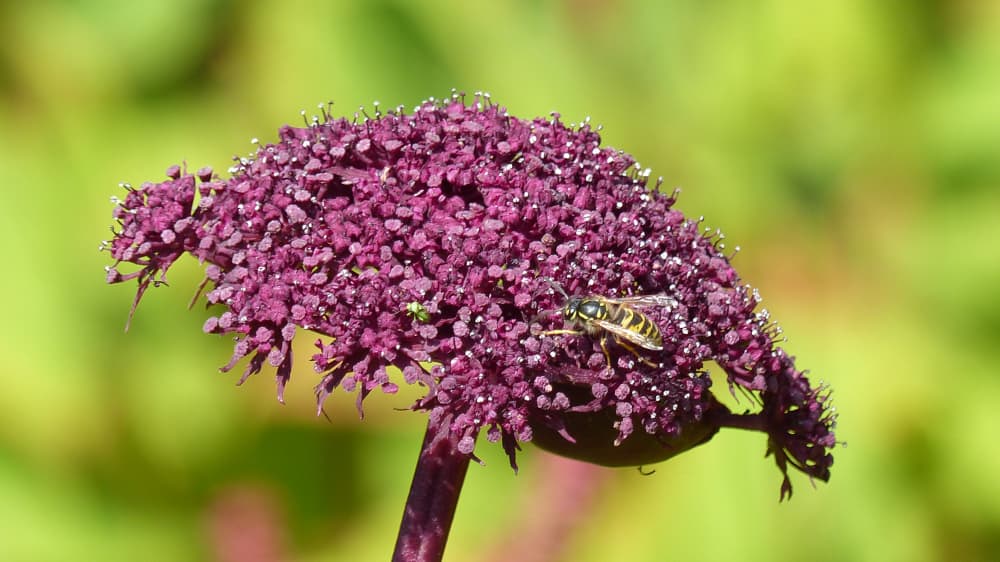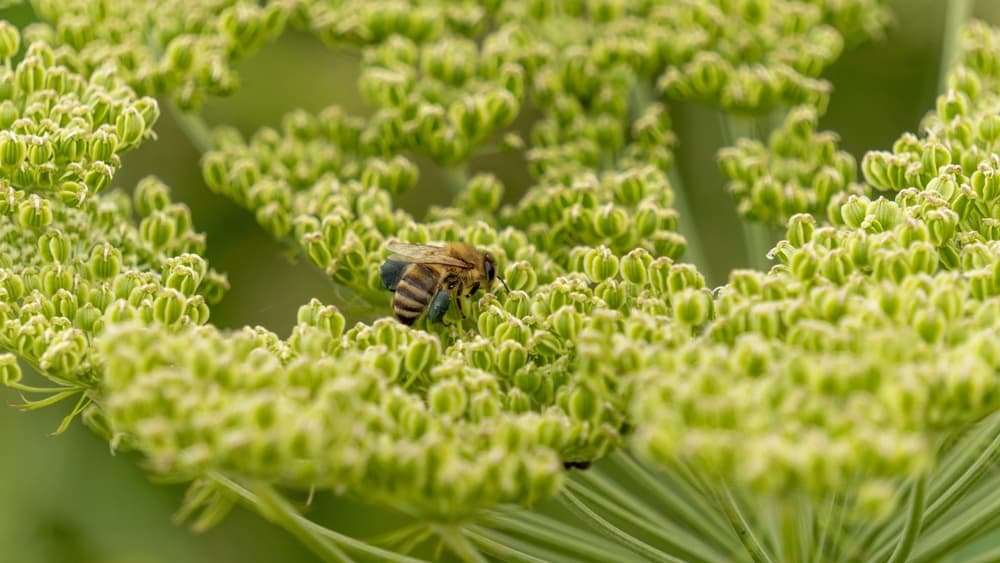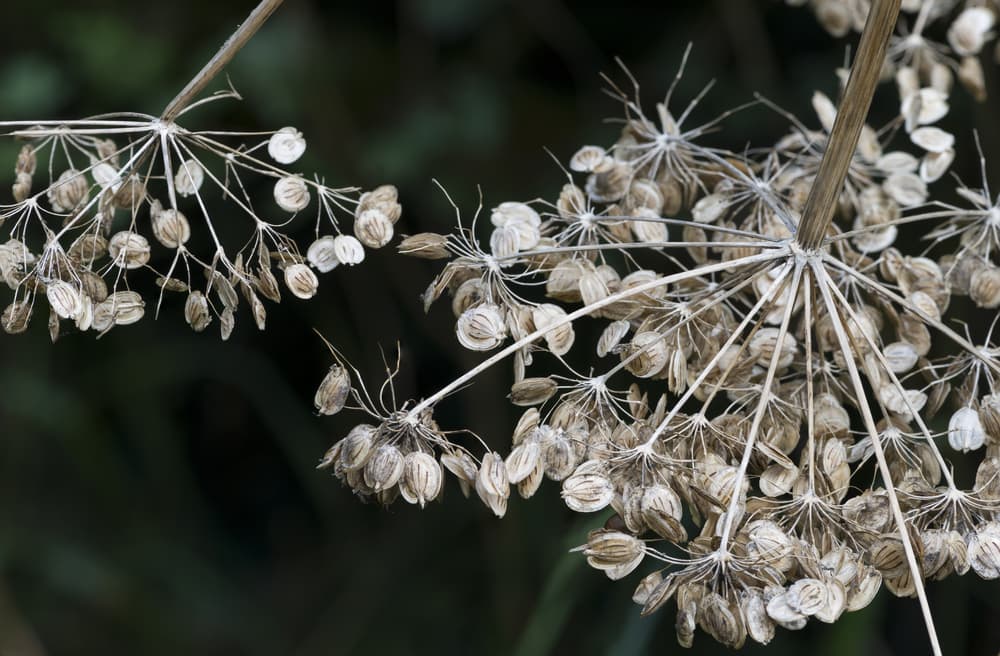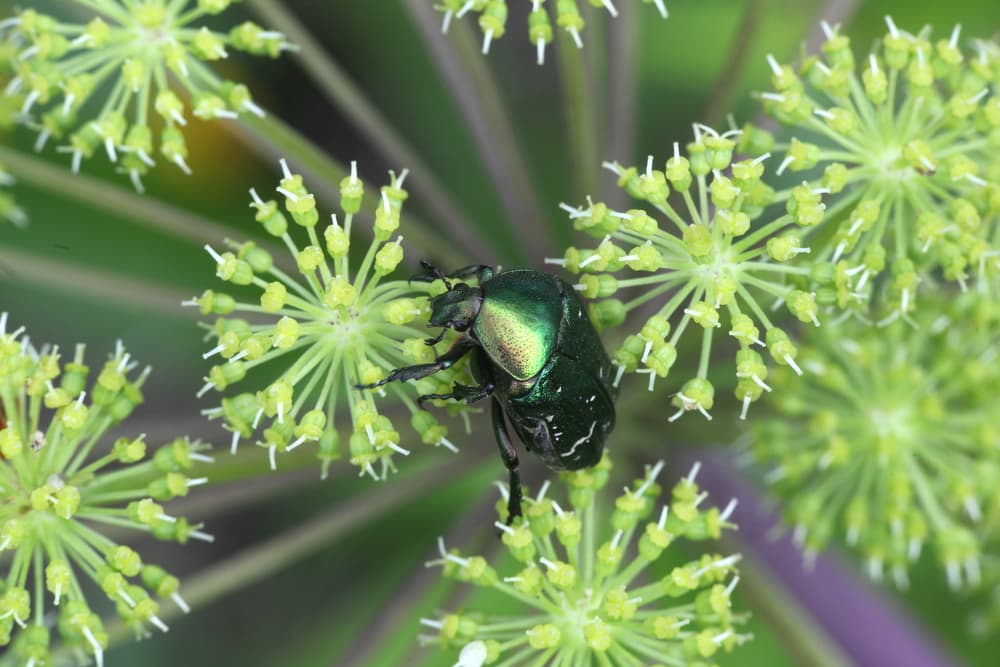BIENNIALS > ANGELICA

Elizabeth is a Permaculture Garden Designer, Sustainability Consultant and Professional Writer, working as an advocate for positive change. She graduated from the University of St. Andrews with an MA in English and Philosophy and obtained a Diploma in Applied Permaculture Design from the Permaculture Association.
Reviewed By COLIN SKELLY

Colin is a Horticulturist and Horticultural Consultant with experience in a range of practical and managerial roles across heritage, commercial and public horticulture. He holds the Royal Horticultural Society’s Master of Horticulture award and has a particular interest in horticultural ecology and naturalistic planting for habitat and climate resilience.
IN THIS GUIDE
ANGELICA GUIDES
Angelica is a useful herb to grow in your garden and is great for a low-maintenance scheme.
This woodland edge or hedgerow plant is common in the ‘wild’ but can also be grown in gardens, where it can bring a huge range of benefits.
This is an attractive plant in a wilder and more relaxed garden scheme, but besides its appearance, there are many more reasons to grow Angelica in your garden.
Overview
| Botanical Name | Angelica archangelica |
| Common Name(s) | Angelica, Angel’s Fishing Rod |
| Plant Type | Biennial Herb |
| Native Area | Eurasia / Northern Hemisphere |
| Hardiness Rating | H6 |
| Foliage | Deciduous |
| Flowers | Small blooms in various hues |
| When To Sow | August, September |
| Plant Out | April, May |
| Harvesting Months | March, April |
Sunlight
Preferred
Full Sun or Partial Shade
Exposure
Exposed or Sheltered
Size
Height
1.5 – 2.5M
Spread
1 – 1.5M
Bloom Time
June – July
Soil
Preferred
Chalk, clay, loam
Moisture
Moist but well-drained or poorly drained
pH
Any
Native to Europe and naturalised in the British Isles, Angelica archangelica (garden angelica) is a biennial plant which is hardy throughout the UK and which is not frost tender.1Garden Angelica. (n.d.). Plant Atlas. Retrieved March 9, 2023, from https://plantatlas2020.org/atlas/2cd4p9h.bkn
This is the plant most commonly referred to when people talk about Angelica.

Angelica grows up to 1.5-2m in height and spread to create bushy clumps around 1m in diameter.
It bears umbels of light yellow flowers in the early summer.
Common Varieties
There is also another useful species within this genus, Angelica sylvestris, or wild Angelica, which could also be a useful addition to your garden.
Technically, both of these species are biennials, however, they can be perennial if they are prevented from going to seed.

And since you can harvest Angelicas for a range of uses prior to seed formation, this maintenance can be minimal and as easy as can be.
There are also other non-European native Angelicas to consider.
One that is commonly grown in a garden is Angelica gigas, for example.

Also known as Korean Angelica or giant Angelica, this is an attractive ornamental, with large purple flower umbels.
There is also the East Asian Angelica edulis, with white flower umbels, and North American native Angelica atropurpurea, which has purple stems, to give just a few examples.
Why Grow Angelica?
Both garden Angelica and wild Angelica have many culinary uses.
Garden Angelica’s leaves are eaten raw or cooked for a liquorice flavour in salads.
They are also used as a mild natural sweetener, often alongside tart fruits or in jam-making.

Both of these Angelicas are excellent wildlife-friendly plants and bring a wide range of beneficial pollinators and other insects to your garden.
Other ornamental Angelicas like Korean Angelica do not have as many uses, but they can attract beneficial wildlife and make good cut flowers.
How To Grow Angelica
Garden Angelica will grow in dappled shade below trees, or in full sun.
It requires deep, moist and fertile soil with an acidic, neutral or alkaline pH.
Wild Angelica can also grow in similar conditions, though it is more shade tolerant and can cope well even in areas of somewhat deeper shade.
Angelicas can be grown:
- In a dedicated herb garden.
- Alongside other perennial herbs, vegetables and flowers in a bed or border.
- Around the fringes of an annual vegetable garden.
- On the edge of a woodland area or beside a hedgerow.
- In a fruit tree guild or forest garden scheme.
It is best to choose a sheltered spot, to avoid the need for the staking that is required in windy conditions, and to avoid any really hot or dry locations.

It works very well alongside other herbs which like similar conditions, like Alexanders, rue, meadowsweet, sorrels and herb patience, for example.
Dill should not be grown close by to avoid cross-pollination.
Angelicas’ ability to attract pollinators and predatory insects like lacewings and ladybirds makes it a great companion for a wide range of annual and perennial crops.
“Angelica is an umbellifer, many of which have a characteristic dome or disc of flowers,” explains Colin Skelly, a horticulturist with years of experience in the field.
“Think of Cow Parsley (Anthriscus sylvestris) or Hogweed (Heracleum sphondylium) on road verges; the easy access and plentiful nectar make this group of plants very popular with pollinators.”
Sowing
Angelica seeds are usually sown in a cold frame or another undercover area immediately once they are ripe, in late summer or early autumn, since the seeds typically only remain viable for a short period of time.
You can also direct sow Angelica seeds where they are to grow as soon as they are mature.
The seeds can also be sown in spring but germination rates will tend to be lower at this time of year.

One key thing to remember when sowing Angelica is that the seeds need light for germination.
So it is very important to place seeds on the surface of the soil or growing medium and to barely dust them over, or to leave them uncovered.
Bury them too deeply and they may not germinate at all, or germination rates will suffer.
Planting Out
If you are not direct sowing, once the Angelica seeds germinate, and the seedlings are large enough to handle, they should be pricked out and potted up into their own pots.
You can place these in a cold frame, polytunnel or unheated greenhouse, and watered to maintain moisture, but not overwatered over the winter months.
These young Angelica plants should then be planted out into their final growing positions in the spring.
Angelica Care
Angelica is a relatively low-maintenance choice – great for busy gardeners.
It requires little care, especially once established.

It can be perennial if it’s not allowed to go to seed in its second year, and if you do decide to let it go to seed (which can be beneficial for the birds who like to eat them) then this is a plant that can self-seed readily – sometimes even so readily that it becomes a nuisance.
Watering
Young Angelica, especially while growing in pots and not in the ground, should be well-watered when grown undercover or during dry spells outdoors.
Even mature plants might need to be kept well watered if rainfall is not sufficient, as dry conditions can increase the chances of diseases like powdery mildew taking hold.
Feeding
As long as it is grown in fertile soil, Angelicas should not need additional fertiliser.
Add a mulch around your plants to maintain fertility and retain soil moisture over time.
Common Problems
Aside from powdery mildew, which can be a problem especially in dry conditions, Angelica is rarely troubled seriously by pests or disease.

Look out for slugs and snails when the plants are still young and protect them where necessary.
Later, Angelica attracts aphids, but since it also attracts those creatures which prey on aphids, like ladybirds and lacewings, this issue will usually balance itself out in a healthy garden and the Angelica will help you keep the beneficial wildlife around and the ecosystem in equilibrium.
Harvesting
Harvest the leaves and stems in the spring, while they are still young.
Usually, these should be harvested before June.
Division
Mature Angelica plants in their second year can be cut back to the ground and dug up to make new plants in autumn.

Divide the roots with a sharp knife and repot or replant the divisions right away where they are to grow.
As you can see from the above, Angelicas can be a great choice for a productive, attractive, low-maintenance and wildlife-friendly garden.
References
- 1Garden Angelica. (n.d.). Plant Atlas. Retrieved March 9, 2023, from https://plantatlas2020.org/atlas/2cd4p9h.bkn

